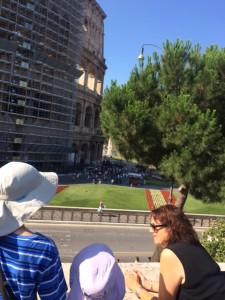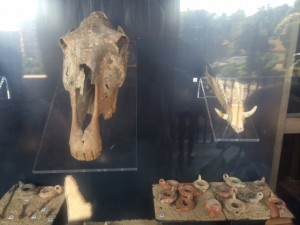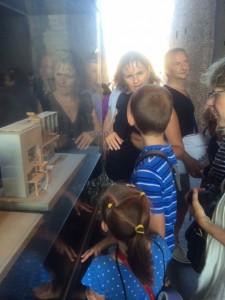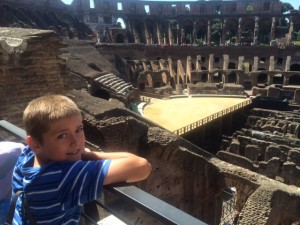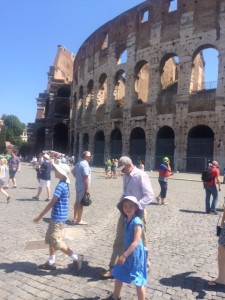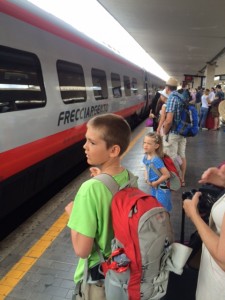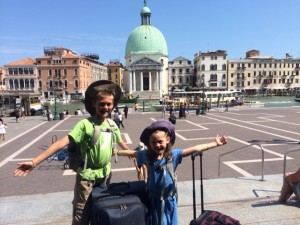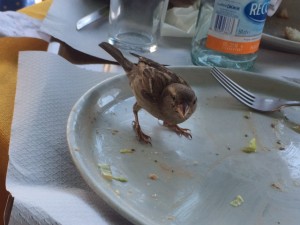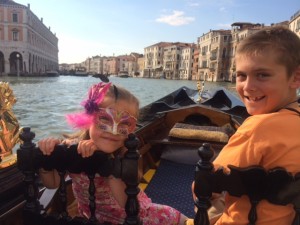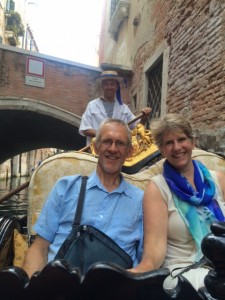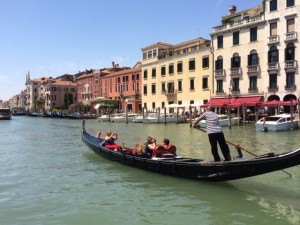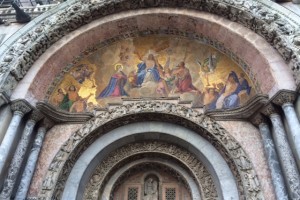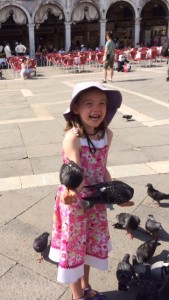Walking on the Via Francigena from Gambassi Terme to San Gimignano.
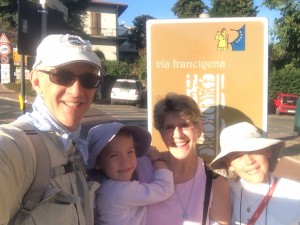 We awoke just before the sun first peaked above the eastern hills and quickly we made ready for our journey. The forecast called for mid-90 degree weather, and we knew that each moment the sun shone, the temperature would swiftly rise. Finally we got out the door about 6:45 and made it to Gambassi Terme a few minutes after 7am. The sign just outside the Church of San Maria a Chianni announced the Via Francigena, and off we went at 7:20am.
We awoke just before the sun first peaked above the eastern hills and quickly we made ready for our journey. The forecast called for mid-90 degree weather, and we knew that each moment the sun shone, the temperature would swiftly rise. Finally we got out the door about 6:45 and made it to Gambassi Terme a few minutes after 7am. The sign just outside the Church of San Maria a Chianni announced the Via Francigena, and off we went at 7:20am.
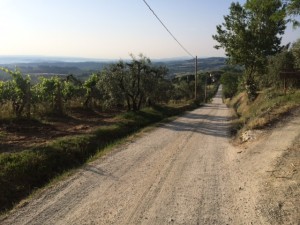 The first kilometer descends on twisting tarmac and we had to watch the road and traffic. It was a relief to leave that behind and to be on a farm road that descended gradually toward the valley below. A view of San Gimignano in the distance set the goal right before us. The air was still cool, and our spirits high. “Come walk with us the journey is long…” Naomi and I sang, as the road descended past vineyards and olive groves, enjoying the still and abundant beauty of the vistas, morning bird song, and the joy of the road.
The first kilometer descends on twisting tarmac and we had to watch the road and traffic. It was a relief to leave that behind and to be on a farm road that descended gradually toward the valley below. A view of San Gimignano in the distance set the goal right before us. The air was still cool, and our spirits high. “Come walk with us the journey is long…” Naomi and I sang, as the road descended past vineyards and olive groves, enjoying the still and abundant beauty of the vistas, morning bird song, and the joy of the road.
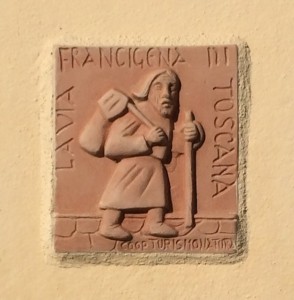 From the beginning the trail was well marked—something I’d hoped for and somewhat expected, but one never knows—besides, I’d left the map on the kitchen table and would have to depend on that signage even more so! Traveling with other pilgrims (most today spoke Italian) also allowed us to be more confident. But again, every fork in the road was well marked with V.F. or the pilgrim symbol and accompanying arrows and signs that made it abundantly clear where we were to walk.
From the beginning the trail was well marked—something I’d hoped for and somewhat expected, but one never knows—besides, I’d left the map on the kitchen table and would have to depend on that signage even more so! Traveling with other pilgrims (most today spoke Italian) also allowed us to be more confident. But again, every fork in the road was well marked with V.F. or the pilgrim symbol and accompanying arrows and signs that made it abundantly clear where we were to walk.
Along the way I talked about Archbishop Sigeric, the newly appointed bishop of Canterbury Cathedral, who had made this journey around 990 to Rome to receive his pallium from the Pope[1], and who kept a diary of his stops on his return journey—a diary which survived and is a unique document detailing the Via Francigena Road and the churches in existence along the road at that time. We imagined him sharing in the same vistas as we were—with changes, of course—traversing the same streams, and walking up and down the same valleys and hills. And not only him but the 1000’s upon 1000’s of pilgrims who likewise made this physical/spiritual journey over the last millennium, whether for practical reasons or with the expectation that they were on a journey with sacred dimensions.
For the first time since we left Canterbury I felt like we were pilgrims more than tourists; and I felt my heart growing lighter and fuller even while the temperature rose, knowing that together, as a family, we were in the act of fulfilling this long-held goal of walking a stage of the Via Francigena.
The map suggested this stage would be about a 3 hour journey covering 13.4 kilometers (8.33 miles), and I held an unexpressed hope that, for us, 4 hours would do it. Having attained the valley floor, we began ascending, thinking that over the next crest, we’d be rewarded with another view of San Gimignano, but that didn’t happen. We were, however, able to look backwards and to see from whence we’d come, and as Gambassi receded in the distance, we knew that each step was taking us closer to our goal.
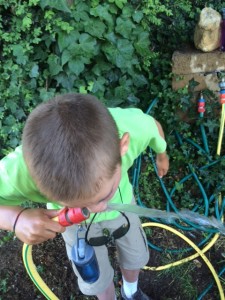
 We passed wineries, small grottos set up to honor St. Mary for ancient or more contemporary appearances and interventions; places that, in some form or another, had been witnessing pilgrims’ journeys for the past 1000 years or more. At one place we found a hose and cold water awaiting us…reminding us of how God provided for the children if Israel during their long journey through the wilderness.
We passed wineries, small grottos set up to honor St. Mary for ancient or more contemporary appearances and interventions; places that, in some form or another, had been witnessing pilgrims’ journeys for the past 1000 years or more. At one place we found a hose and cold water awaiting us…reminding us of how God provided for the children if Israel during their long journey through the wilderness.
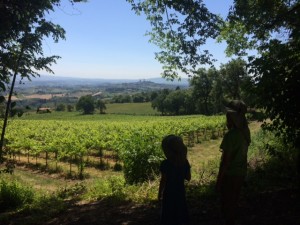 Finally, having come up a long, long stretch of uphill walking, including passing several swimming pools— pure torture!—the sight for which we had longed greeted us at last—San Gimignano’s towers were before us, now so much closer at hand. Still, looks are deceiving when traveling, and it was much further and took us much longer, than we expected before we would finally walk through SG’s great stone gates.
Finally, having come up a long, long stretch of uphill walking, including passing several swimming pools— pure torture!—the sight for which we had longed greeted us at last—San Gimignano’s towers were before us, now so much closer at hand. Still, looks are deceiving when traveling, and it was much further and took us much longer, than we expected before we would finally walk through SG’s great stone gates.
By now, it was well over 90 degrees. Kai walked with me for much of the second half of the journey, sometimes holding my arm, sometimes singing with me “the ants go marching…” and making up verses along the way, while Naomi walked with Chris. Naomi had found her rhythm and would swing both arms forward at once, somehow finding this a helpful strategy as we worked our way up the hills.
As we made it to the outskirts of San Gimignano traffic increased. There was a couple kilometer section where we had to be quite vigilant around curves. But finally, after the roundabout announced we were officially in town, we found firm and safer footage on the sidewalk, and began our the final ascent to the old city, hunting every slice of shade we could find, as our energies waned and the temperature continued to climb.
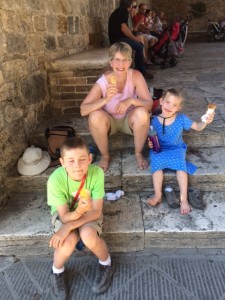 Once within the gates we stopped for water—AH! the indescribable sensation of rinsing off sweaty arms, hands and faces—and then followed the stone trail to the main plaza in the center of town, where we knew gelato awaited us. Where was that world famous gelato we’d had a taste of two days before?!
Once within the gates we stopped for water—AH! the indescribable sensation of rinsing off sweaty arms, hands and faces—and then followed the stone trail to the main plaza in the center of town, where we knew gelato awaited us. Where was that world famous gelato we’d had a taste of two days before?!
After a 7:20am start, it was now 12:30pm. Our journey from Gambassi Terme had taken just over 5 hours. And as we ate our treats at last we rested in the shade and discussed our next move. (for the record, Erik and Kai both had mango and fragola, Naomi had chocolate and mango, and Chris had all Michell, a flavor she’d discovered a couple days earlier, which combined orange peel, saffron, honey, and almonds). Soon we were back at Poggio ai Chieli, our Agriturismo farm near Ulignano, enjoying the pool and the deep satisfaction of knowing that we’d had a wonderful, challenging, and rewarding journey that gave us as a family a taste of the pilgrim’s road.
Why pilgrimage? I always think better when I’m on my feet. The noise of thoughts gradually falls away, my head clears. The physical act is in line with what the human body was designed to do: walk. But the pilgrim’s journey is spiritual as well as physical. One is called to live in the current moment, to experience what the road brings in terms of nature’s gifts, vistas, insights, discoveries, challenges. As the clutter falls away, one’s soul opens to a deeper dialog with oneself and with the Divine.
Being on the pilgrim road puts me in the company of other pilgrims–both ancient and contemporary–and the sense of community it commends—whether or not one has named companions. It is a journey toward transformation. As we journey from one hill town to another, this sense of community is also enlarged by offers of hospitality and welcome, and the promise that unexpected gifts and graces will be received.
When we started our walk at San Maria a Chianni in Gambassi, we gathered in a circle and prayed that our journey would be marked by joy and kindness, and that our eyes would be opened to see things around us. I’m so grateful to say that this, indeed, was our experience. I’m so proud and thankful for the way our children—indeed each of us—trekked those 13+ kilometers in rising heat without complaining or getting cross, but with humor and with a sense of community. Via con Dios…we go with God.
[1] The pallium is an ecclesiastical vestment in the Roman Catholic tradition bestowed by the pope on bishops and archbishops as a symbol of the jurisdiction delegated to them by the Holy See.

